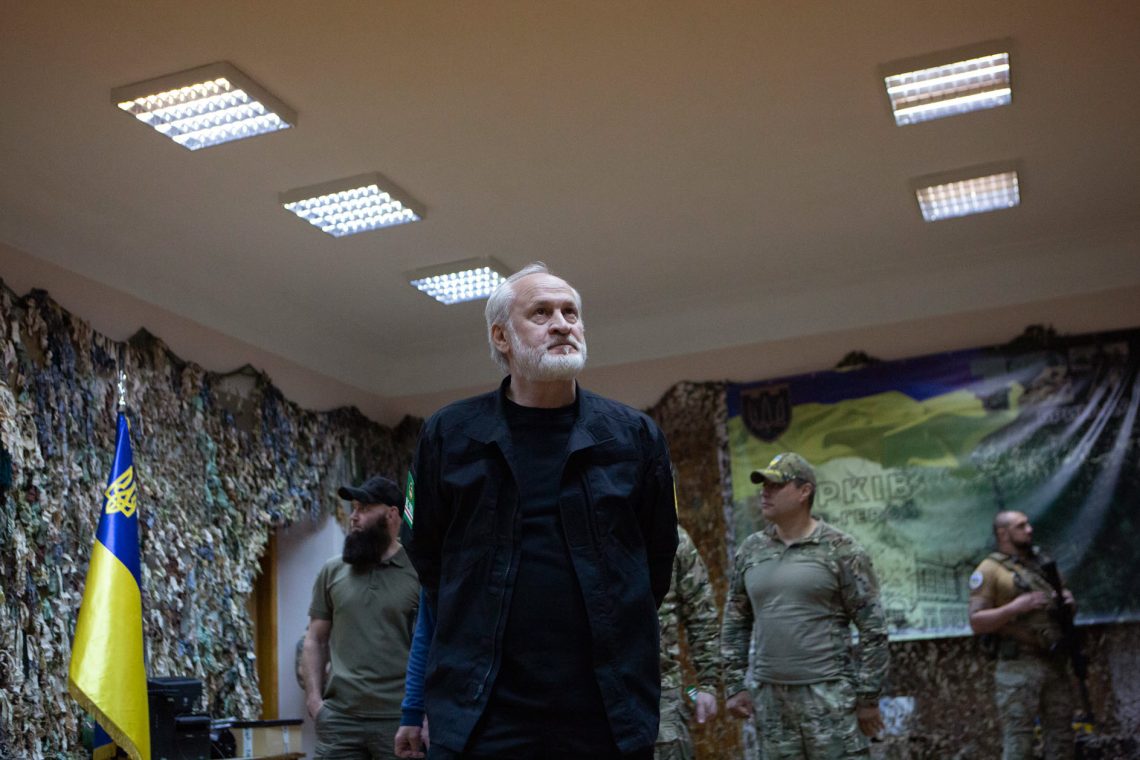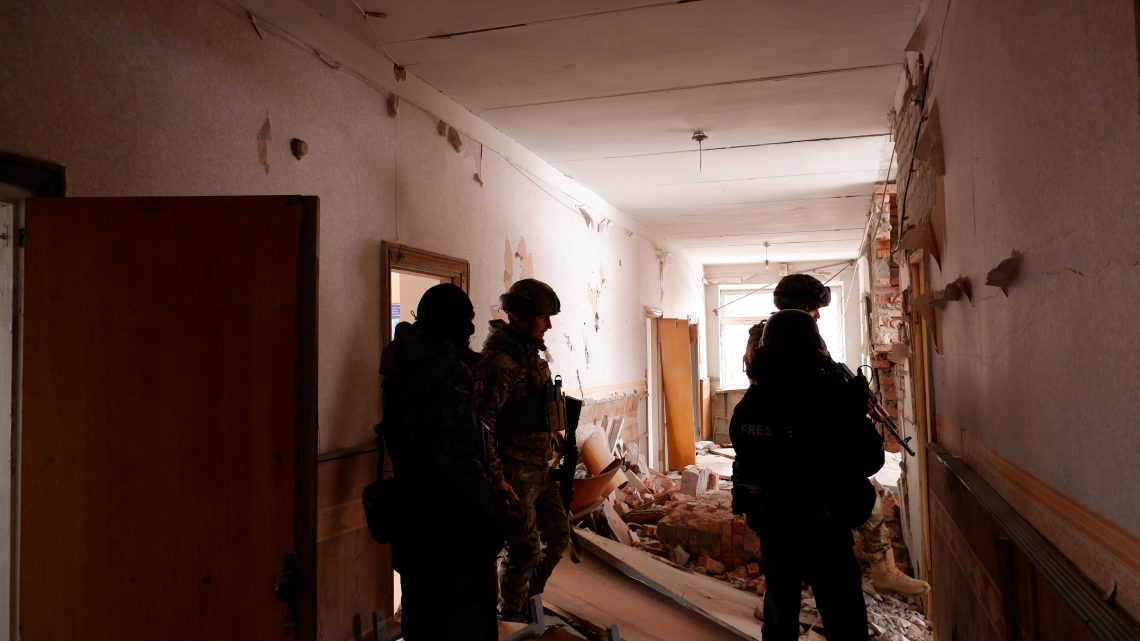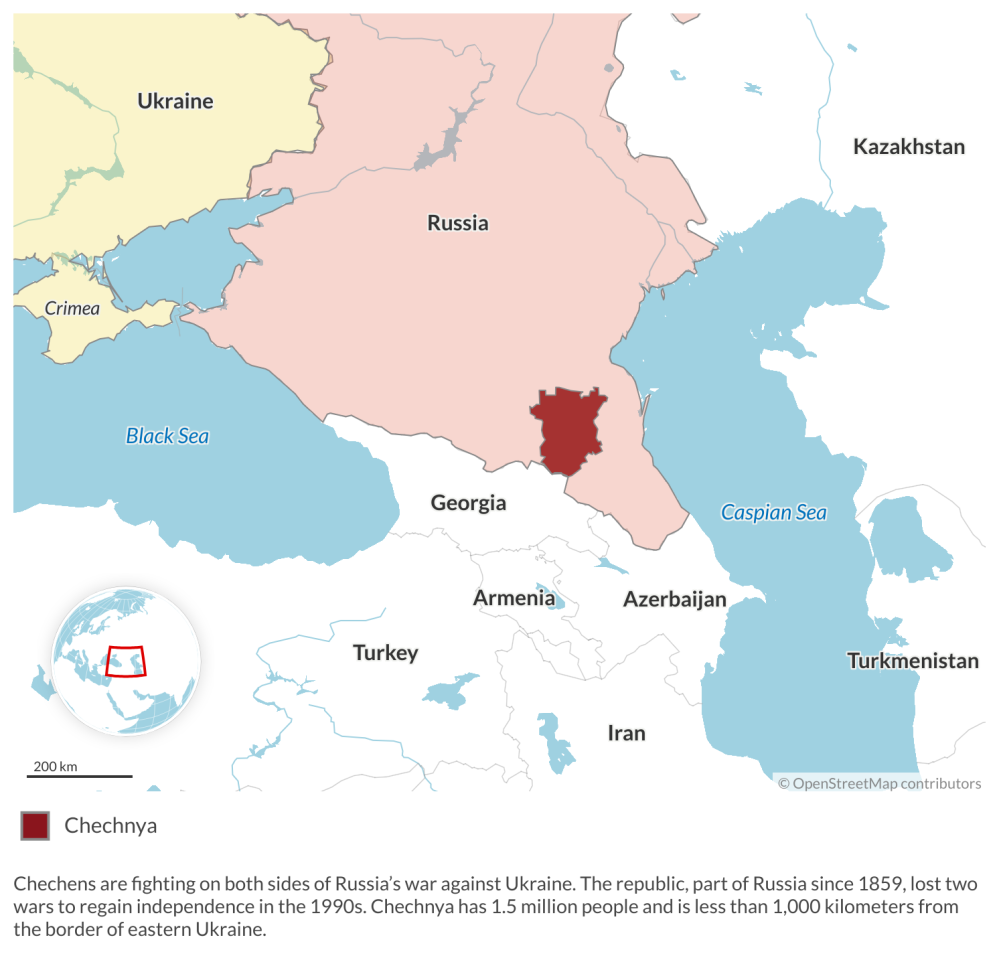Eyewitness to war: Why Chechens fight for Ukraine
While Chechen leader Ramzan Kadyrov’s followers are loyal to the Kremlin, other Chechens see the war as an opportunity to defeat Russia and regain independence.

In a nutshell
- Chechen units fighting for Ukraine are respected for their performance
- The soldiers are integrated into the military despite cultural differences
- They seek to destabilize Russia by encouraging separatist movements
When it comes to Russia’s war against Ukraine, Chechens are on both sides.
The military units under Ramzan Kadyrov, the Kremlin-appointed leader of the Chechen Republic since 2007, are actively supporting Russia’s “special military operation” in Ukraine.
However, a significant number of Kremlin-opposed Chechen fighters have taken up arms on Ukraine’s side. These fighters play an important role within the Ukrainian command structure. The motives of the fighters on Kyiv’s side are mixed. While genuinely supportive of Ukrainian independence, they are also interested in the training and weaponry to support their bid for independence from Russia and the revival of the independent Chechen Republic of Ichkeria, which existed, de facto, from 1991 to 2000. Ichkeria is the preferred name by inhabitants who view Chechnya as a Russian-imposed term. The Chechen Republic today has roughly 1.5 million people and is less than 1,000 kilometers from Ukraine’s eastern border.
The chance that these fighters will go on to foment a revolution in Chechnya is small but not impossible. If such an uprising happens, it could trigger other separatist revolts by ethnic groups in various republics and, ultimately, lead to the fragmentation of the Russian Federation. If these Chechens do open a formidable “second front” within Russia, the Kremlin would be forced to divert military resources away from the Ukrainian battlefield and fortify its southern flank.
The truth on the ground
This first-hand assessment is based on operational experience with Lom, a special tactical group that is part of the volunteer Sheikh Mansur Chechen Battalion.
This fierce unit has a proven track record of success within the Ukrainian military command and strong allegiance to their Ukrainian partners. The fighters mirror many of the motivations, internal contradictions and growing capacity of other Chechen units in the Ukrainian theater, offering an insight into the larger geopolitical complexities at play.
Operational security prevents the publication of specific numbers of fighters or allied units, but it is safe to say that the Chechen contingent is a respectable part of Ukrainian defense capacities.
A condensed summary of the Chechen perspective is described by “Niburu,” a Chechen fighter near Bakhmut:
It is necessary to divide the Chechens into two categories: those who have reconciled with the loss of Ichkeria’s independence, and those who only ceased their struggle under duress. At a certain point, resistance to Russian occupation in the Caucasus became feasible only in the form of insurgent tactics, which are not distinctly different from terrorism in the international view, and this path is thankless.
Read more by Paul Schwennesen
Eyewitness to war: Assessing Ukraine’s counteroffensive
Eyewitness to war: Assessing the Ukrainian capacity to fight
A popular uniform patch explains the motivations and structure of the Chechen volunteers in Ukraine. The patch depicts the Ukrainian and Ichkeria flags buttressing the words “ANTI-TERROR.” The esoteric allusion is to the Russian military campaigns of 1994, 1999 and 2008 which subjugated Chechnya under the euphemism of “fighting terror.” Russian troops wore “ANTI-TERROR” markings on their uniforms.
Niburu further notes a key motivating factor for Chechen engagement in Ukraine:
The 2008 [Russian] invasion of Georgia was very short, and the war in Ukraine since 2014 has been the first full-scale confrontation with Russia, offering Chechens a chance to retaliate against their adversary. Therefore, since 2014, many have come to Ukraine to participate in the “gazavat” – a jihad for their homeland. From the current combat experience with Russia, we see that the specific geographical location of the conflict is not so crucial.
“Walid,” another frontline fighter, confirms the sentiment, noting:
The Russian-Ukrainian war increases our chances of the de-occupation of the Chechen Republic of Ichkeria by an order of magnitude since in this confrontation Russia is becoming weaker every day, and the main thing is for the whole world to see the true face of this monster.
Ukraine, in short, has provided an opportune venue for Chechen independence supporters to rally disparate elements within a coordinated campaign against a common historical enemy.
The dynamics of the Chechens’ alliance with Ukraine
Allied Chechen fighters live, train and operate in parallel with their Ukrainian counterparts. They are not directly embedded. At this stage of the war, many have been formally admitted by contract into the ranks of the Ukrainian Ministry of Defense, with commensurate pay and access to supplies and munitions. There are lingering bureaucratic problems over things such as undocumented migration and background checks that prevent some Chechen volunteers from acquiring formal volunteer status within the Ukrainian military, but these represent the exceptions, not the norm.
Culturally, while Chechens stand in firm alliance with their Ukrainian counterparts, they nevertheless operate on a distinctly “separate but equal” footing. Though there are few language barriers (Russian is the de facto lingua franca), the Christian/Muslim divide is fairly pronounced. Despite the religious difference, Niburu says: “It is still amazing that in Ukraine we are all united and trust each other – Muslims, Christians and even my Jewish friends, who still help us with supplies, despite the complex political situation.”
Chechens stay, by and large, within their ranks and relatively little fraternizing exists between Ukrainian and Chechen units.
Facts & figures
Chechens are well-equipped, but training lags
There appear to be few problems in equipping Chechen units at the same standard as mainline Ukrainian units. Access to small arms (5.45mm/7.62mm) is ubiquitous, often supplemented by captured Russian materiel. Modern NATO anti-tank weapons (Javelin, NLAW, AT-4, Bull Spike) are readily available within decentralized logistics networks. Larger or more sophisticated equipment such as armored vehicles, heavy artillery or high-end sniper platforms are difficult to procure, as is the case for all irregular (and many regular) units.
Drones (both surveillance and FPV/attack) are of the highest impact and are deployed by Chechen units in approximate parity with their Ukrainian counterparts. All units actively seek additional drone capacity, as well as upgrades such as thermal imaging and night vision technology.
For field communications gear, Russian forces have started producing radios, “Azart” for example, whereas Ukrainian forces rely almost exclusively on imported civilian Motorola and Hytera radios. Concerns exist about encryption and jamming of these communications, but for the most part, they appear sufficient for the task.
High-quality training, however, is actively sought across all sectors, since, as Niburu notes, it “is lacking for most regular units of the Armed Forces of Ukraine due to the constant recruitment of new soldiers, lack of time and qualified instructors.”
Quality training programs are a somewhat ad hoc affair, at least in the frontline operational theaters I have visited. Some experienced foreign training cadre (primarily from NATO nations but also Israel) have made their way to those in greatest need. But they often find themselves plagued by bureaucratic hurdles and a lack of resources. Ukrainian command staff from field-grade level to general staff are eager to incorporate these trainers but have difficulty getting formal approvals to provide trainers with basic housing, transportation or necessary equipment. A disconnect seems to exist between the widely expressed need for trainers and the Ukrainian willingness to fund such training programs.

Russian instability and possible Ichkeria independence
Compared to other smoldering independence movements within Russia such as in Bashkiria, Karelia, Komi, Mordovia, Kalmykia and others, Niburu notes that Ichkeria stands as perhaps the most restless of the splintering factions. His commander, Mohammed, estimates that upwards of 80 percent of the Chechen population favors independence. The impulse this faction represents is further amplified by its unique strain of Islamic separatism – a tension seen elsewhere in the North Caucasus in places such as Dagestan, Ingushetia, North Ossetia and Circassia, but most evident in Ichkeria.
The commander of the Lom special tactical group Aslan Ocherkhadzhiev notes:
If the existing Russian power structure collapses, there will be an administrative vacuum in the corresponding territory for some time. The world’s leading states and military-political blocs will compete for influence in the post-Russian space, which is likely to vary in different regions depending on the ethnic and religious identity of the resident peoples. Most regions will probably seek the patronage of Western countries, primarily the United States and the United Kingdom, hoping to improve their standard of living. However, the specifics of regions with a predominantly Muslim population, especially in the context of local public opinion on the current Israeli-Palestinian conflict, give reason to expect them to gravitate toward an alliance with wealthy Middle Eastern countries, including Saudi Arabia, Qatar, the United Arab Emirates and Turkey.
Given the growing influence of the BRICS nations, this gravitation may be of some concern to many in the West. In the short term, however, Chechen fighters continue to live and operate on Ukrainian frontlines, contributing welcome fighting prowess to the resistance. Their dedication to weakening Russian capacity is, of course, beneficial to their immediate desires to see Russian influence in Ichkeria weaken. However, their help for Ukraine is more than a merely cynical alliance of convenience: both sides share a common desire to be free from central Russian authority and to chart their courses as free peoples.
Scenarios
Unlikely: Chechens stop helping Ukraine
Chechen fighters will not cease their alliance with Ukraine anytime soon. While many of the fighters are homesick and eager to play a more active role in their nation’s independence, the war in Ukraine presents them with the immediate opportunity to destroy their Russian enemies, earn a steady paycheck and plan future separatist action.
Somewhat likely: A rekindled independence movement in Ichkeria
An active insurgency movement may rekindle in Ichkeria, utilizing training and equipment gained in Ukraine to press their advantages. The gambit would be risky and would require firm commitments of weapons and training from allies. However, especially for Ukraine, such commitments might prove especially well-placed, forcing Russian military planners to redeploy their already overstretched forces yet thinner, possibly hastening a Russian defeat in Ukraine.
More likely: Chechens will be patient
Chechen units will bide their time in Ukraine, aiding their allies and gaining technical proficiency. They will wait for the moment in which Russia is at its lowest ebb, either in a Donbas-centered quagmire or during an active, chaotic withdrawal from Ukraine. This will be their moment to initiate a coordinated guerilla resistance movement that can prevail against their weakened adversary.
For industry-specific scenarios and bespoke geopolitical intelligence, contact us and we will provide you with more information about our advisory services.










